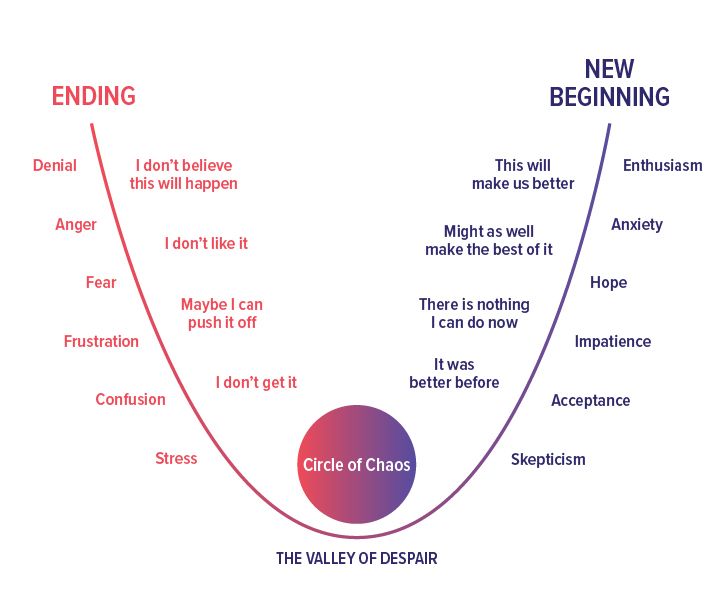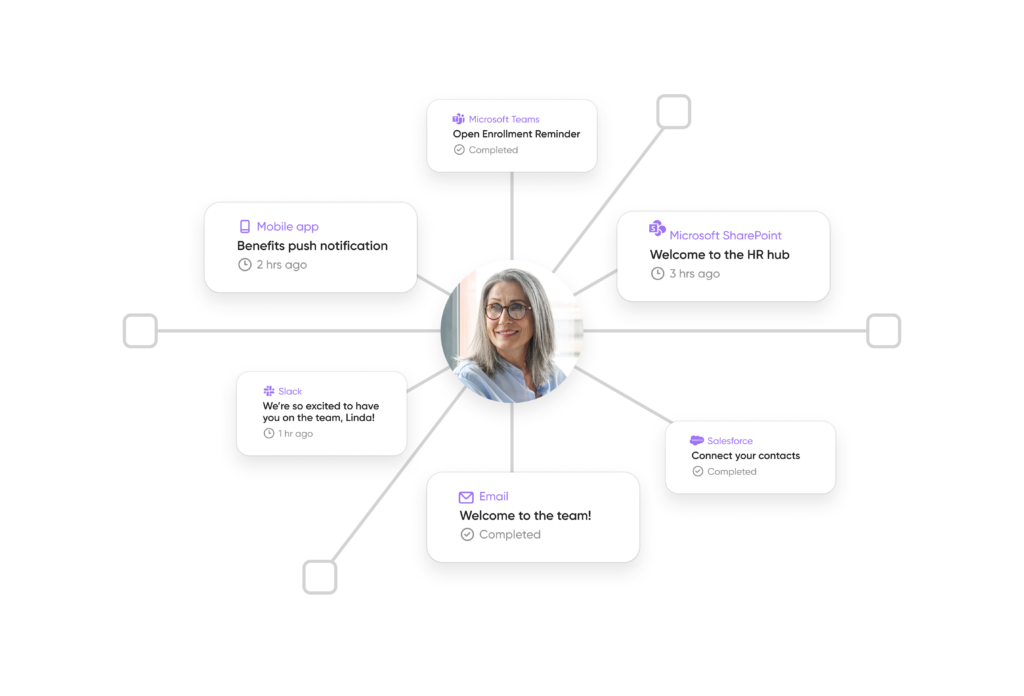Table of Contents
Change is a constant in today’s business landscape, and the ability to navigate it effectively is key to survival and growth. The secret sauce for highly effective organizational change management lies in blending the right mix of stakeholders, strategy, communications, and training—supported by intelligent orchestration that aligns every part of the organization.
Merely developing and launching an internal project, initiative, or system at your organization doesn’t automatically ensure employee engagement and adoption, especially when employees are deeply immersed in their everyday projects, juggling numerous demands, and being inundated with communications. That’s why more organizations are leaning on orchestrated, personalized experiences to cut through the noise and drive real behavior change.
70% of change programs fail to achieve their goals, largely due to employee resistance and lack of management support. McKinsey and Company
According to a 2024 report by IBM, organizations that implement effective change management strategies can increase revenue growth by up to 22%. This underscores the value of having a well-structured change management approach—one that not only minimizes disruption but also aligns people, processes, and communications to drive measurable business outcomes through every stage of the transition.
Key insights
- Implementing cross-functional teams and data-driven leadership can increase the success rate of change initiatives by 28%, highlighting the importance of a robust and orchestrated change management process.
- A well-structured change management plan reduces resistance, improves communication, and fosters long-term adoption during the change process.
- The change management process involves preparing and guiding an organization through changes in goals, processes, or technologies.
- Different types of organizational changes, such as fundamental, transformational, and developmental, require tailored approaches to effectively implement change.
- Key elements of a change management plan include a detailed description of the change, stakeholder roles, resources, timeline, and key performance indicators.
- Continuous monitoring, feedback, and adjustments are crucial for the long-term success of change management initiatives, ensuring the management plan remains effective.
Benefits of a well-structured change management process
A well-planned change management process can mitigate the risks associated with change and ensure a smooth transition. It provides a framework that reduces resistance and risk, improves communication, and fosters long-term adoption of the new system or process. A thoughtful change management plan is crucial in addressing employees’ emotions and behaviors during the change, ensuring they feel supported and understood. With a structured approach, organizations can not only manage the immediate impacts of change but also embed the new ways of working into the organizational culture—ensuring sustained improvements and benefits.
Change management strategies
Common change method strategies include the ADKAR model, Kubler-Ross Change Curve, and Kotter Methodology. At the foundation of all change management models is effective communication. Using any of these models in conjunction with the key steps below will ensure transparent communication and effective change stickiness.

Steps to create a change management plan
Step 1: Align stakeholders around a cohesive vision
Before starting your change initiative, recruit a minimum of two project sponsors—including an executive-level sponsor—and various stakeholders representing all facets of the business to serve on a stakeholder team and align on a shared vision for the project. Ensure stakeholders agree with your overarching strategy so they’ll be compelled to communicate the necessity for this change across the entire organization and to impacted employees. When seeking executive buy-in, it’s crucial to present key points that demonstrate the value and benefits the change will bring to the organization. Highlight how the proposed change integrates with the organization’s overarching strategic goals, enhances communication, boosts productivity, nurtures collaboration, and elevates employee engagement. Emphasize how the change will streamline workflows and processes, saving time and effort, and illustrate how it can lead to cost savings by improving communication and optimizing resource utilization.
Step 2: Craft your blueprint for success
Once the vision is in place, it’s time to map out your strategy. Rally the stakeholders and dedicated project team to collaboratively design a robust strategy, followed by forming a governance and project management plan. This plan should meticulously outline due dates, decision-making processes, key decision-makers, scheduled meetings, and communication strategies, both within the team and to the entire organization. Regularly update the stakeholders and company on the progress, enhancing employees’ readiness for change. It’s crucial to update all employees throughout the project process to help prepare them for the change.
What are the key elements of a change management plan? Consider including the following:
- Description of the change: Provide a detailed explanation of the change, including the current state, desired future state, and specific changes needed, with a change request form documenting the process.
- Background and context: Explain the reasons driving the change and the potential benefits to the organization.
- Anticipated areas of impact: Identify the departments, teams, processes, and systems affected by the change.
- Stakeholders and their roles: List the stakeholders involved and their roles to ensure clarity of responsibilities.
- Required resources and budget: Outline the financial, human, and material resources needed for the change.
- Timeline of the change process: Provide a detailed timeline with key milestones, deadlines, and the overall schedule for implementation.
- Goals and final outcome: Define the specific, measurable objectives and expected outcomes of the change initiative.
Step 3: Navigate change with readiness sessions
The next step is to conduct change readiness sessions with the entire company. These sessions will provide a high-level overview of the new project, effectively highlighting the difference between the old and new ways of doing things. This helps employees specifically understand what is changing. In these sessions, discuss pertinent questions such as: What are we doing well? What can be improved? How can we assist you in navigating this change? Encourage questions from the employees, even if you don’t have all the answers at that moment. These sessions serve as a valuable tool to identify potential training needs, user experience (UX) improvements, and future communication requirements. Given the inherent difficulty of change, create a supportive environment for employees to express their feelings. Consider incorporating exercises like the Change Valley of Despair.

Step 4: Launch an early adopters program
Once your design and communications are about 80% complete, initiate an early adopters program. Identify influential individuals within your organization who can serve as change advocates. Engage them early to solicit valuable feedback on various items such as UX, communications, or training. Have them review the communications and encourage them to ask questions, which will provide insights for necessary adjustments. To foster a sense of involvement, consider offering incentives such as branded swag or “Ask Me” shirts for them to wear on the change go-live day, reinforcing their active participation in the initiative and reinforcing adoption of the new way of doing things with their employees.
Step 5: Amp up communications and start training
Kick off the next stage by rolling out go-live communications and launching comprehensive change management training for employees. Communicate multiple times and in multiple ways to ensure employees see the messages. The Firstup intelligent communication platform can help you create and send hyper-personalized campaigns that reach every worker at the right time and in the right channel. Increase engagement by breaking through the noise and ensuring employees receive essential information.
Decide what type of training would most impact adoption. Your training plans could include workshops, eLearning modules, training videos, FAQs, and guides. In this phase, reiterate the “why” of the change but shift focus toward the “how” to guide your audience through the specifics. Conduct stabilization surveys to ensure the shift to the new intranet has been effective. Surveys in the first few weeks after launch help assess the effectiveness of your change management efforts. Employee feedback helps ensure a smooth transition by identifying areas of improvement and evaluating change management communication, training, and overall platform performance.
Follow up with subsequent check-ins at 30, 60, and 90 days. This proactive approach aids in addressing employee queries, refining FAQs, and implementing additional communications as needed. Depending on the change initiative, you can use a variety of data to measure change stickiness—analyze engagement and adoption metrics, along with help desk tickets, to fine-tune communications, training modules, and user experience based on valuable feedback.
Step 6: Motivate employees and recognize achievements
Introduce an enticing element into the mix—beyond communication and training—by incorporating gamification to solidify the adoption of new behaviors. Gamification elements help make the change journey more engaging and enjoyable. Implementing a recognition program is also pivotal during change. Recognizing and appreciating employees’ efforts in a timely, sincere, and specific manner not only reinforces positive behaviors but also cultivates a sense of accomplishment and value.
These motivational tools create a supportive environment, mitigating resistance to change and fostering a collective momentum toward the envisioned transformation. Combining motivation, recognition, and gamification within change management practices proves instrumental in inspiring and empowering employees throughout the transition.Reduce Change Fatigue
Remaining ingredient
These six steps are proven change management methodologies to facilitate transitions within your organization. The most important ingredient, however, is personalized communication—delivered through intelligent orchestration. Communication and employee experience platforms like Firstup make it possible to automate, personalize, and orchestrate messaging at scale. Traditional digital experiences, such as mass emails on major changes and training programs, often fall short—especially for the deskless workforce who may not have access to email. Even with email access, there’s no guarantee the message will be read among the 347 billion emails sent daily.
The answer lies in embracing personalized communication, akin to the individualized experiences customers encounter. Think about the convenience of receiving notifications from Alexa about a delivered package or a reminder about your child’s birthday list. Implementing this level of internal personalization with change management communications ensures the message reaches each worker in the most accessible way. Personalization based on an employee’s role, location, and needs is the key ingredient for successful change management implementation.

Conclusion
Effective change management involves a comprehensive approach that includes stakeholder alignment, clear communication, risk management, and continuous monitoring. By implementing these strategies, organizations can navigate change more successfully.
Change is a constant in the business world, and the ability to manage it effectively is a critical skill. Embracing change with a well-structured plan—and reinforcing it with intelligent orchestration—can help organizations thrive in a constantly evolving landscape.
FAQ
What is change management?
Change management is the process of preparing for and guiding an organization through changes in goals, processes, or technologies. It involves implementing strategies to manage and control change while helping people adapt. This structured approach ensures that significant or complex changes are executed smoothly and effectively.
What are the 3 main types of change management?
Fundamental change: Large-scale shifts such as mergers, acquisitions, or restructures. These changes impact every facet of the organization and require careful planning to minimize disruption and resistance.Transformational change: Significant operational changes like adopting new software or business solutions. These changes aim to improve performance and drive growth by altering operations fundamentally.Developmental change: Smaller-scale changes addressing immediate risks or challenges. These quick adjustments enhance current processes or mitigate issues.
How can I regularly review team progress in a change management plan?
Use a project management tool to monitor milestones and deadlines. Schedule regular check-ins to discuss updates and address challenges. This helps manage change effectively and keeps everyone aligned with the articulated change management plan.
What are the key elements of a successful change management plan?
A successful change management plan includes a detailed description of the change, background, impact analysis, stakeholder roles, resources, timeline, clear goals, and ongoing communication. Tracking progress and managing resistance are also crucial. This well-thought-out change management plan ensures a smooth organizational change.
Can you provide a change management plan example?
A change management plan example includes sections like Introduction, Objectives, Stakeholder Analysis, Communication Plan, Training Plan, Risk Management, Timeline, and Evaluation Metrics. Using a management tool can help organize and track these components effectively.
What is the importance of an articulated change management plan in managing change?
This type of change management plan provides a clear roadmap, helping communicate the vision, goals, and steps to all stakeholders. This clarity reduces resistance, increases buy-in, and ensures a smoother transition—making the change initiative more likely to succeed.
How do I track progress during the change management process?
Set clear milestones and performance indicators from the beginning. Use a project management tool to track these metrics and conduct regular reviews to assess progress. This allows for timely adjustments and ensures alignment with organizational goals.
Why is a change management plan considered just the beginning in an organizational change?
A change management plan is just the beginning because it requires continuous monitoring, feedback, and adjustments to ensure long-term success. Regularly review team progress and make necessary tweaks to the change management plan to address emerging challenges and opportunities.
How can I effectively implement change within my organization?
Effectively implementing change involves a well-structured change management plan that includes clear communication, stakeholder engagement, and comprehensive training. Regularly updating employees and incorporating their feedback can significantly enhance the implementation process.
What are the key performance indicators (KPIs) for a successful change management plan?
Key performance indicators for a successful change management plan include metrics such as employee engagement levels, adoption rates of new processes, reduction in resistance, and overall project timeline adherence. Tracking these KPIs helps ensure the change initiative is on track and achieving its goals.
Table of Contents
Related posts
Subscribe via Email
Subscribe to our blog to get insights sent directly to your inbox.




